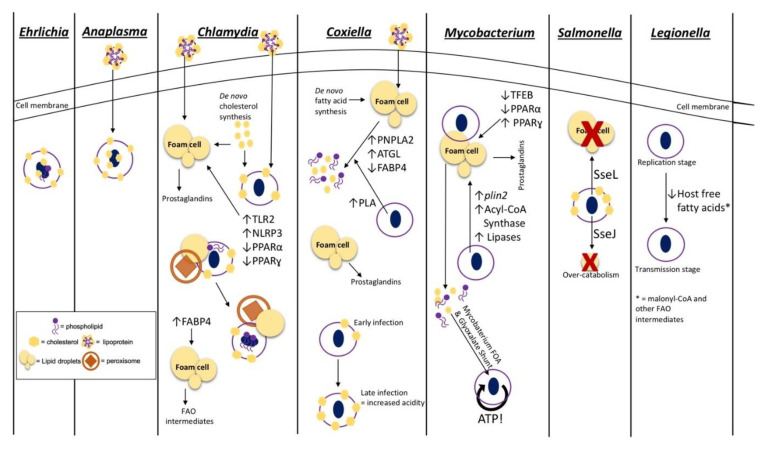Figure 1.
Mechanisms for acquisition and utilization of host lipids by intracellular pathogens. Intracellular pathogens that reside within a vacuole utilize host lipids for various processes during infection. This model depicts the host lipid pathways and methods exploited by various vacuolar bacterial species to enhance intracellular and, ultimately, mammalian infection. The approaches employed by these pathogenic bacteria include (i) lipid acquisition into pathogen-associated membranes as seen in Ehrlichia, Anaplasma, Chlamydia, and Coxiella (from left to right); (ii) pathogen- and host-stimulated lipid droplet modulation required during Chlamydia, Coxiella, Mycobacterium, and Salmonella infection (from left to right); (iii) immune modulation and lipid inflammatory mediator production from lipid droplets seen during Chlamydia, Coxiella, and Mycobacterium infection (from left to right); (iv) acquirement of host fatty acid β-oxidation (FAO) metabolites for energy production by Mycobacterium and modulation of host FAO regulators by Chlamydia; (v) regulation of bacterial stage transition of Legionella initiated by host intracellular lipid composition. The legend on the bottom left-hand side of the model shows a representative image of the structures used in the panels describing each pathogens’ utilization of host lipids. Toll-like receptor 2 (TLR2); NOD-like receptor protein 3 (NLRP3); peroxisome proliferation activation receptor α (PPARα); peroxisome proliferation activation receptor ɣ (PPARɣ); adipose triglyceride lipase (ATGL); fatty acid binding protein (FABP4); patatin-like phospholipase domain containing protein 2 (PNPLA2); transcription factor EB (TFEB); perilipin 2 (plin2).

